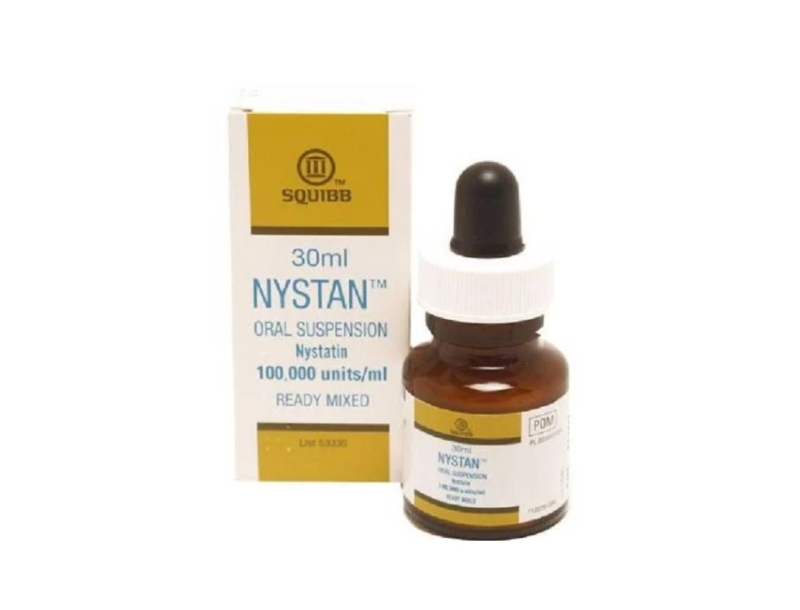Nystatin Oral Suspension

* Images for illustrative purposes only
* Brand supplied may vary depending on stock availability
Same-day Service Available
Same-day service available for additional £10, conditions apply.

* Images for illustrative purposes only
* Brand supplied may vary depending on stock availability
Same-day service available for additional £10, conditions apply.
No appointment or long waiting times
Your information always remains private
All our doctors & pharmacists are qualified & based in the UK
Dispensed by our UK partner pharmacies


Choose from our treatment options or speak to the in-store pharmacist for advice

Complete our free online medical consultation to be reviewed by our Clinical Team

We will notify you when your medication is ready for collection
Nystatin is an antifungal medication used to treat infections caused by Candida species, including oral thrush, esophageal candidiasis, and gastrointestinal fungal infections. It belongs to the polyene class of antifungal drugs and works by binding to ergosterol, a vital component of fungal cell membranes, creating pores that lead to cell leakage and death.
Nystatin is available in various forms, including oral suspension, tablets, lozenges, and topical creams or ointments, making it versatile for different types of fungal infections. The oral suspension is commonly swished and swallowed or spit out, while the lozenges are dissolved slowly in the mouth. Topical forms are applied directly to the affected skin areas.
Follow the instructions below to ensure appropriate use of this medication:
Always use this medication exactly as your clinician has told you. Check with our clinical team or your GP or pharmacist if you are not sure.
Medicines and their possible side effects can affect individual people in different ways. The following are some of the side effects that are known to be associated with this medicine. Just because a side effect is stated here, it does not mean that all people using this medicine will experience that or any side effect.
Nystatin is generally well-tolerated, but like all medications, it can cause side effects. These side effects can range from mild to severe and may vary depending on the form of Nystatin used (oral, topical, etc.). Below is a detailed list of potential side effects:
Gastrointestinal Symptoms
Nausea: Feeling sick to the stomach, which may sometimes lead to vomiting.
Stomach Upset: General discomfort in the stomach area, including pain or cramping.
Diarrhea: Loose or watery stools that may occur occasionally.
Vomiting: The act of expelling stomach contents through the mouth, which is less common but can occur.
Mouth-related Symptoms
Bad Taste in Mouth: A lingering unpleasant taste after taking the medication.
Mouth Irritation: Minor irritation or soreness in the mouth, which can occur with the use of oral suspensions or lozenges.
Skin Reactions
Rash: Red, itchy, or bumpy skin which may appear after taking the medication.
Hives: Raised, itchy welts on the skin that may be red or skin-colored.
For full information on side effects and correct use, see the patient information leaflet. If any side effects concern you, or you are experiencing any of the side effects mentioned in the patient information leaflet whilst taking this medication, please contact our clinical team or speak to your GP.
Liver Toxicity: Very rare but can occur, especially with prolonged use or in patients with pre-existing liver conditions. Symptoms include jaundice (yellowing of the skin or eyes), dark urine, and abdominal pain.
Kidney Problems: Also rare, but possible in some cases. Symptoms include changes in urine output, swelling in the ankles or feet, and fatigue.
Fever: A temporary increase in body temperature which is uncommon.
Hypersensitivity Reactions: Generalized allergic reactions which might include symptoms like itching, hives, and rash.
Use in infants, pregnant or breastfeeding women, and individuals with pre-existing conditions should be under the guidance of a healthcare provider to minimize risks.
Get emergency medical help if you have signs of an allergic reaction to this medication. These include:
It is important that you let us know which prescription, over-the-counter medicines and recreational drugs you are currently taking. You must also tell us about any other medical conditions that you currently have (or had in the past). This will help us ensure the prescribed medication is safe and appropriate for you to take.
For full information on warnings, medication interactions and contraindications, refer to the Patient Information Leaflet. Please read all packaging and the Patient Information Leaflet before taking any new medicine and inform our clinical team or your GP of medicines you are taking or intend to take.





